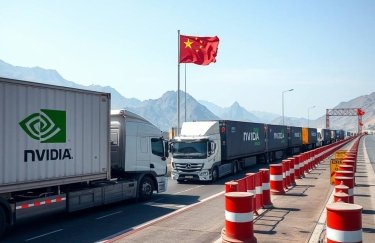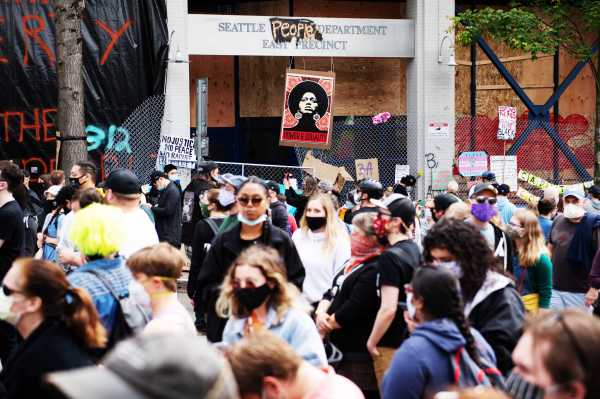
Share this story
-
Share this on Facebook
-
Share this on Twitter
-
Share
All sharing options
Share
All sharing options for:
Seattle’s newly police-free neighborhood, explained
-
Reddit
-
Pocket
-
Flipboard
-
Email
After eight days of continuing clashes with protesters, staff at the East Precinct police headquarters in Seattle suddenly vacated the building on Monday, June 8, shredding documents and leaving it empty.
Among protesters, there was initial confusion over why police would outright leave, but organizers suspected a trap.
“The SPD seem like what they wanted to do is abandon the East Precinct and then wait on the borders, just like a few blocks away, for somebody to try to set a fire to repeat what was going on in Minneapolis,” Carla, a protester who is being identified by a pseudonym to protect her privacy, told Vox. “Then they can rush in and say, ‘Now our use of military force against unarmed civilians is justified.’”
But that’s not what happened. Instead, protesters set about creating a peaceful — and safe — police-free neighborhood. And the officers largely haven’t bothered to come back.
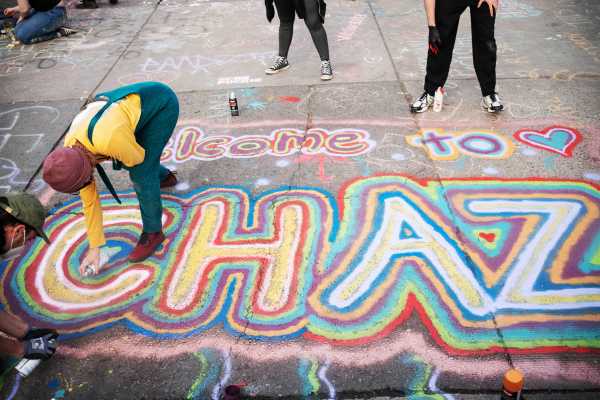
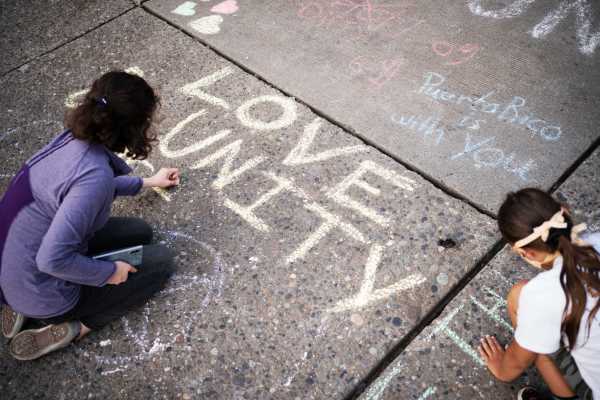
The Capitol Hill Autonomous Zone, or CHAZ as it was referred to early on, started as a meme, said Carla. “I was there the morning after the East Precinct was abandoned, and CHAZ was sort of just a joke that people were sharing, like, ‘Oh, this is an autonomous zone,’” she told Vox, referring to an area that is free from the local government structure and control.
But the idea soon took off among the protesters. City personnel showed up the day after the precinct was abandoned to remove the barricades that police had set up to control the protests, but protesters convinced the workers to let them set up roadblocks to keep city traffic out of the area. They ended up sequestering an approximately six-block area in the central Seattle neighborhood of Capitol Hill.
“This is the urban core of the city,” Seattle City Council member Kshama Sawant, whose district encompasses the protest area, told Vox. “It’s dense and it has a long history, including of LGBTQ rights activism in the ’80s.”
CHAZ has since evolved further into a center of peaceful protest, free political speech, co-ops, and community gardens. Protesters have invited the city’s houseless population, who had been subject to a mass “clearing” of tent communities throughout the city, to come stay in the neighborhood. Movie nights have been held, including Mississippi Burning, about two FBI agents investigating lynchings of black people and activists in Mississippi during the civil rights era.
“There was an impromptu dodgeball game,” said Carla. “There are people smoking weed in circles … and just having normal conversations, and then 20 feet away, you have this large group of people standing around somebody with a megaphone talking about Marxism.”
The zone, where hundreds of people can be found on any given day, is largely leaderless, with decisions often being made by vote. But volunteers have stepped in anyway, doing everything from distributing food to cleaning up garbage in the area. The vibe there is pretty relaxed, said Carla.
“It’s really hard to pin this place down,” she said. “This is a place that is built and maintained by marginalized people, and they’re the voices that are driving this.”
Yet right-wing media has painted CHAZ as some kind of war zone, portraying the tiny neighborhood as if it were forcibly seceding from the US. While protest organizers in the area are understandably reticent to speak with reporters — several protest leaders did not respond to interview requests from Vox — there is no hint of the violence suggested by the likes of Fox News.
There are also goals to the protests. Organizers put out an extensive list of demands in a Medium post on June 9, broken into four categories: the justice system, health and human services, economics, and education. They include defunding and abolishing the SPD, an end to the school-to-prison pipeline, and the de-gentrification of Seattle, among many other demands.
Nine days into the zone’s creation, its name has also evolved, as it’s now known as the Capitol Hill Organized Protest, or CHOP. But regardless of what it’s called, the run of events that brought the zone into existence was an extraordinary demonstration of protester organizing — and police incompetence.
The protests that gave birth to CHOP
Sparked by the death of George Floyd at the hands of the police in Minneapolis, Minnesota, mass protests have broken out all over the country over the past several weeks, and Seattle saw some of the most intense demonstrations.
“There’ve been multiple protests throughout the city on a daily basis,” Sawant told Vox. “One of the key sort of battlegrounds happened to develop at the 11th and Pine intersection on Capitol Hill.”
According to Sawant, who was at the Capitol Hill protest the evening of June 7, which saw the most intense police crackdown of the week, it was police who first turned violent against otherwise peaceful protesters in the area. “One moment I was having political conversations with a group of young people about how do we fight police violence and racism and how that connects to capitalism itself,” she said. “And the next moment, I felt mace in my eyes. And then a few moments later, there was tear gas and flash-bang grenades going off. Somebody counted hundreds of them the next morning.”
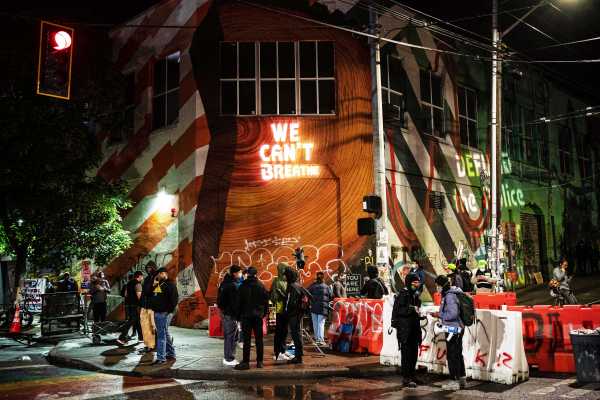
The violence of police crackdowns on otherwise peaceful protesters sent shock waves throughout the liberal city. During the preceding week, calls for Seattle Mayor Jenny Durkan to step down began to grow louder.
“That violence lies at the doorstep of Democratic establishment and Mayor Durkan,” said Sawant. “There started to be calls for Durkan to resign because people were correctly horrified at this violence. People were just stunned that this is Seattle in 2020.”
The day after the protest, police vacated the precinct building, and even now, more than a week later, no one knows who ordered it. Neither Durkan nor Police Chief Carmen Best has taken responsibility. “We were asked to do an operational plan in case we needed to leave,” Best said at a press conference Thursday. “The decision was made. We’re still evaluating about how that change came about but it didn’t come from me.”
However, Best disputed the characterization that it was abandoned in the first place. “We did not abandon the precinct, but we had to remove personnel for a short period of time,” Best told Good Morning America on Friday.
While police haven’t yet moved directly against protesters, officers have been seen in and around the precinct building over the past several days, according to social media reports.
Right-wing panic over the protest zone
Initial media reports about the zone, especially at Fox News and throughout the conservative mediasphere, portrayed the autonomous zone as a kind of anarchist threat to society. One notorious Fox News live hit included a graphic indicating that the network was reporting from the US-CHAZ border, as if the zone were no longer part of the United States.
Further, several right-leaning media outlets reported that local business owners had been approached by armed anarchists who demanded mob-like protection payments. That has since been debunked by business owners who explained that it was false and that the local businesses were racking up much-needed sales after being hit hard by the coronavirus pandemic.
Then, on June 12, Fox News was busted by the Seattle Times for photoshopping an image of a gunman with a green mask into images of protesters in the area.
But the initial reports were enough to catch the attention of President Donald Trump. On June 11, Trump tweeted at Washington Gov. Jay Inslee and Durkan to “take back” the city by force before he was compelled to intervene.
People on the ground inside the protest zone have been encouraging one another not to believe media reports or rumors over what’s happening in the zone unless they see it themselves.
“It’s a game of telephone,” Carla said. “I’ve gotten into the habit of just saying if you don’t know the person that you’re talking to, and if you don’t have the full context of a video clip or an audio clip, then just assume that it’s deliberate misinformation. Ask yourself who stands to gain from that kind of misinformation.”
Life inside the CHOP
One of the reasons for all the conservative media hoopla is that autonomous zones like this don’t happen all that frequently. Like CHOP, Camp Maroon in Philadelphia is a recently created autonomous zone of houseless people with their own list of demands for city and state officials.
Even with the inaccurate reporting, that isn’t to say there isn’t some discord at CHOP. According to Carla, the name change and subsequent confusion came from an internal struggle between two groups of protesters with differing visions for the area. For days, Carla said, there has been a power struggle between organizers who envisioned the zone as a peaceful, organized protest against police violence, and another group who wanted to see CHOP become more of an anarchist space where marginalized people could obtain mutual aid when needed.
While the protest does have some loose leadership, there are few formal structures. Sawant compares the space to the “Night of 500 tents” during the Occupy Wall Street movement in Seattle in October 2011, of which she was a part. Back then, Occupy protesters were able to drive police from their space before police returned and cleared out the area where the protests took place.
Already, said Sawant, CHOP has outlasted what they were able to achieve with that Occupy action, which only lasted three days. But she said she expects police to clear the area sometime in the near future. “I don’t think that we can in any way assume that the police will not come back and specifically attack this space,” she said. “I think we should expect that that could happen at any moment, because that’s exactly what happened in Occupy.”
In the meantime, protesters have managed to create a police-free space in which black people, indigenous people, people of color, queer people, and houseless people feel especially safe. It’s even become somewhat of a tourist attraction for more affluent white, liberal families.
“Talking with my friends and talking with a couple of people on the ground, I keep hearing people say, ‘I never felt this safe walking in the city,’” said Carla, noting that the anti-homeless architecture and corporate feel of the neighborhood has largely given over to graffiti and friendly faces. “The knowledge that the police aren’t there [has created] this feeling that this is a space that belongs to everybody.”
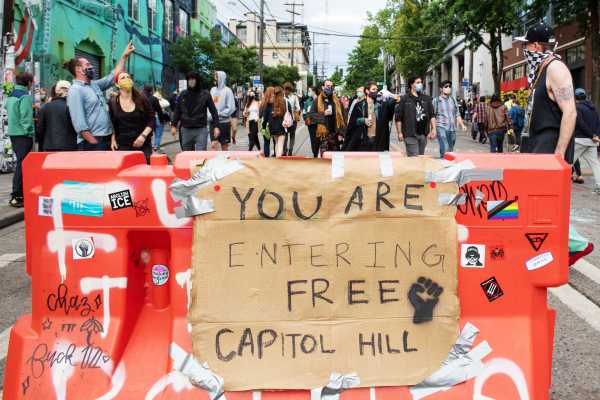
Sawant has a more complex explanation. “We have an interest in having safe neighborhoods, but what makes neighborhoods unsafe is not the absence of police,” she said. “What makes neighborhoods [and] neighbors unsafe, and what generates the conditions for crime, predominantly is economic inequality and injustice.”
For her part, Sawant is introducing several measures at the city council level to address the demands of protesters, including turning the East Precinct building into a community center, cutting the city’s police budget, and permanently banning the use of less lethal force against protesters by police.
Both Carla and Sawant hope the space persists into the future as a place for protesting and political organizing. But Sawant also notes what an achievement it’s been to show the world that these protests don’t need harsh crackdowns in the first place.
“Only days ago, that same space on Capitol Hill was a war-like scenario with the police inflicting 100 percent of violence and brutality against peaceful protesters,” said Sawant. “Since the young people were able to win this political battleground victory, they have been able to demonstrate [they can create a space] which is welcoming, peaceful, and multiracial.”
Support Vox’s explanatory journalism
Every day at Vox, we aim to answer your most important questions and provide you, and our audience around the world, with information that has the power to save lives. Our mission has never been more vital than it is in this moment: to empower you through understanding. Vox’s work is reaching more people than ever, but our distinctive brand of explanatory journalism takes resources — particularly during a pandemic and an economic downturn. Your financial contribution will not constitute a donation, but it will enable our staff to continue to offer free articles, videos, and podcasts at the quality and volume that this moment requires. Please consider making a contribution to Vox today.
Sourse: vox.com
